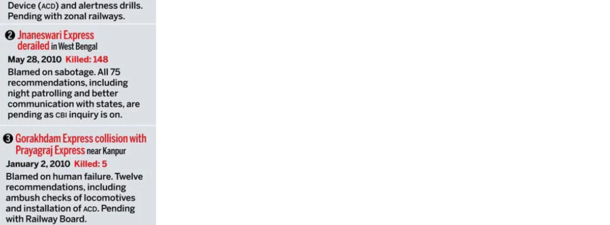
The train accident that happened on last Friday in Odisha, India is one of the worst on the Indian tracks in terms of casualty figures in over two decades – 288 and counting with over 800 injured. But after 119 fatal accidents since the first – collision of Avadh Ashram Express and Brahmaputra Mail at Gaisal in West Bengal’s North Dinajpur district in 1999 that claimed 285 lives, the irony is the status of a high-level safety report submitted over a decade ago is “still in progress”.
The seriousness with which India takes action on train accidents can be gauged from the fact that after the Gaisal incident India has witnessed 119 major train accidents that have killed and injured hundreds, including incidents of communal and terrorist attacks, blasts and arson on trains. But over 100 cases were caused by derailment and collision, including at least three involving the Coromandel Express last week.
Since 1993 to date, the parliament’s standing committee has presented 28 reports on the railways with an elaborate report by a high-level safety review committee under Dr Anil Kakodkar, which was presented to the ministry of railways in February 2012. In this report, published 11 years ago and in the it was highlighted that a system or an efficient mechanism to detect on-course collisions need to be implemented. There are names for such systems with different nomenclatures – anti-collision device system to collision avoidance system to “Kavach”.
This initiative of the railways was well received and well appreciated as it created a hope that this would go a long way in bringing down the rate of accidents. Since then, a lot of modernisation has taken place in terms of signalling, introducing new trains, e-ticketing, increasing speeds of the existing trains etc. As India increased the speed of trains, “Kavach” was expected to be meticulous about safety features in terms of technology and subsequently prepare the human resources.
Soon after news of the horrific train accident in Odisha came out on the evening of June 2, people began asking questions about the “Kavach” system introduced by the Union government, which was supposed to make rail travel safe. Opposition leaders have called out the Union government for its huge delay in implementing “Kavach”.
“Kavach” could have prevented or mitigated the impact of the accident. Had the track and train been equipped with “Kavach”, the probability of a collision between two trains would have decreased drastically, if not averted altogether. It could have reduced the speed of the train and prevented the collision, if both the trains were fitted with the said technology. Also, the Coromandel Express would not have entered the loop line as the good train was already there and it would have alerted the loco pilot.
India had well understood the importance of this system. But when it came to implementation a lot is still to be done. Answering questions about Kavach in Parliament sessions, Railway Minister Ashwini Vaishnaw said on March 29, 2023, that Kavach has been deployed only on 1,455 km of the rail route, out of which 576 km is in the state of Maharashtra. However, no progress seems to have been made between August 2022 and March 2023. And on March 23, 2022, the Minister told the Parliament that 1,098 km were completed on the South Central Railway. This is least considering that Indian Railway is fourth largest in the world with running track length of 102,831 km.
Roll out of “Kavach” has been slow, India is yet to cover even a miniscule percentage under existing trains. The new trains, including Vande Bharat, have the system built in though.
Coromandel Express did not have the collision device installed in it. The high-level safety report said in its present form, the anti-collision device (ACD) was not a safety system and not yet fully engineered for ATP equivalence in standalone form. As the off-the-track loco position sensing through GPS as used in ACD, is a diverse technique and, therefore, is a promising concept but automatic train protection systems are necessary to prevent collisions due to drivers passing signals at danger (SPAD).
Installing Kavach on a locomotive presently costs Rs 70 lakh and a station Rs 40 lakh, with the cost of installing it on a level crossing separate. This is something that needs attention. Problem areas need to be recognised, but thesystem is lax. It is understandable that implementing in one of the largest networks is a challenge, but we need to catch up sooner than later.







No Comments
Comments for Challenges are immense, solution is meniscus are now closed.